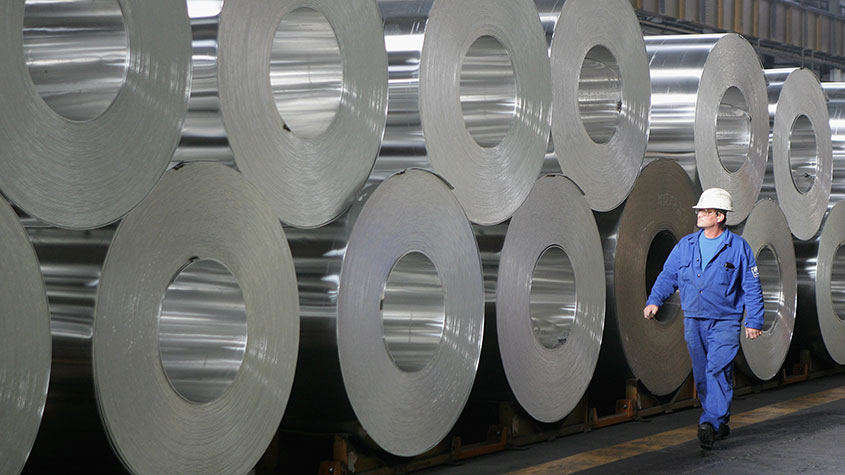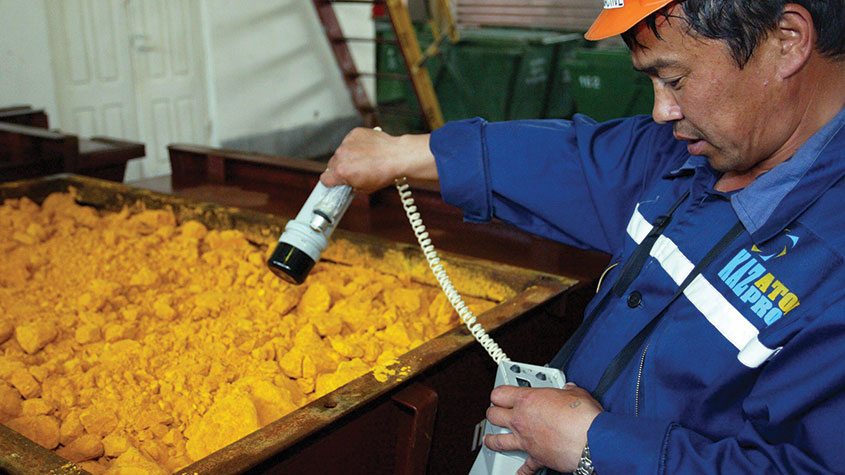Ready to motor: it’s platinum’s turn to shine
Palladium and rhodium have outstripped platinum in the past few years. But thanks to the advent of fuel-cell cars, that could soon change, says Dominic Frisby.


The main platinum group metals (PGMs, as they are known) are palladium, rhodium and, of course, platinum itself. They are all precious metals, in the sense that they are both rare and expensive. Indeed, palladium and rhodium are pricier than gold rhodium, at $5,350/oz, is three-and-a-half times the gold price. Platinum, at under $1,000/oz, is currently cheaper, but this is anomalous.
That said, precious though PGMs might be, they are not monetary metals. Both gold and silver were once used as money; PGMs mostly weren't. You might buy gold as insurance, as a hedge against monetary debasement or to preserve wealth. One of the most effective ways to store gold and silver wealth is on your person. Jewellery accounts for a considerable portion of gold and silver demand. There is considerable jewellery demand for platinum too. It is beautiful and hard, and so can be used in a purer form than gold, which jewellers often deem too soft in 24-carat form. Around 35% of annual platinum demand comes from the jewellery industry. Palladium jewellery, however, has never really taken off. And as for rhodium, have you seen what it looks like? So while PGMs may be precious, they are largely industrial metals. They are the most efficient catalysts known to science, and their price is determined by the automotive industry. Roughly 85% of palladium and rhodium demand is down to the metals' use in catalytic converters. Want to know where the price of each is going? Then you need to assess future vehicle demand.
Petrol, diesel or electric car engines?
Palladium tends to be used in petrol engines, although rhodium is the more effective catalyst for tackling nitrous oxide emissions in petrol engines around seven times more effective than palladium. There is no substitute for rhodium. Platinum's main use, meanwhile, is in diesel vehicles. It can substitute for palladium in petrol engines, but this only tends to be economic when the palladium price is double that of platinum. If palladium is $2,000/oz, for example, and platinum $1,000, you will start to see substitution take place.
MoneyWeek
Subscribe to MoneyWeek today and get your first six magazine issues absolutely FREE

Sign up to Money Morning
Don't miss the latest investment and personal finances news, market analysis, plus money-saving tips with our free twice-daily newsletter
Don't miss the latest investment and personal finances news, market analysis, plus money-saving tips with our free twice-daily newsletter
At more than $5,000/oz, the rhodium price is at highs not seen since 2008 and the frenzy of the pre-financial-crisis commodities bubble, when it got above $10,000/oz. Palladium is closing in on $1,800/oz. Every new week seems to bring a new record high. As for platinum, it ought to be more expensive than gold. Historically, it trades at 1.25 times the gold price. If gold is at $1,500/oz, platinum should be somewhere around $1,800. But it isn't. It is at $950, a long way from its 2008 high at $2,100.
As a result, we are not far off the point where platinum substitution for palladium kicks in. The reason? The Volkswagen emissions scandal of 2015, when it emerged that the car manufacturer had been understating emissions from its diesel vehicles. The resultant regulatory change has seen European demand for diesel vehicles fall, and demand for petrol ones rise. This has been duly reflected in platinum and palladium prices. Seven out of every ten diesel cars sold in the world were sold in Europe before the scandal broke. Over 50% of cars sold in western Europe were diesels. But in September 2019 diesel's market share was 29%. This figure continues to fall.
The other major market for diesel is India. The outlook for diesel light-passenger-vehicles, and thus for platinum, is not good. The market clearly thinks diesel vehicles that use platinum-dominant catalysts will largely be replaced with petrol vehicles with palladium-dominant catalysts. It expects European demand to fall in line with the rest of the world. And as platinum demand falls, so palladium demand rises.
The diesel slump is priced in
However, it is only diesel light-passenger-vehicle demand that is in demise. Demand for diesel commercial vehicles has stayed constant on a global basis and is likely to stay that way. In other words, the big falls in demand have already, mostly, been priced in. Platinum demand should be fairly constant from here. The lows for platinum came a year ago at $750/oz; today's price, $200 higher, reflects that.
What about electric vehicles? They are coming, no doubt, though they are not quite as clean as the keenest proponents would have you believe. Roughly 85% of global energy comes from burning hydrocarbons, so even for electric vehicles there's a strong chance that the ultimate source of their energy is dirty, even if the vehicles themselves emit no carbon dioxide. Nor will electric vehicles signal an end to PGM demand.
Hybrid cars appear to be the way forward. JPMorgan says hybrids will account for 23% of global sales by 2025. But hybrids still burn fuel 91% of vehicles will still have an internal combustion engine in 2025. In 2030, 85% of passenger cars, says the Boston Consulting Group, will still have a combustion engine and hence a catalytic converter. In other words, there will still be demand from vehicles for PGMs.
The PGM supply squeeze
On a supply-demand level things look better for palladium and rhodium than they do platinum. Palladium has an annual deficit of 8%. It has been in deficit for the past seven years with further deficits forecast until at least 2020 and 2021. The market is, in short, structurally undersupplied. The result is a rip-roaring bull market which has seen palladium prices triple since the beginning of 2016, up 40% this year alone. But caveat emptor: palladium, like silver, is a volatile beast. Shenanigans in Russia, the world's largest palladium producer, don't help.
Rhodium is suffering from similar supply shortages. Demand is expected to exceed annual mined supply of 760,000oz by 100,000oz next year, and 200,000oz per year for the five years after that. Extraordinary deficits are predicted. (The shortage of mined supply in both metals is covered by recycling.) Platinum is closer to equilibrium. Over 70% of global platinum is mined in South Africa, where the weak rand, alongside high palladium and rhodium prices, means that profitability is outrunning wage and power inflation. That and the diesel issue mean the fundamentals are nothing like as bullish for platinum as they are for other PGMs. Even so, platinum has managed to gain 20% this year, riding on the tails of other, more popular PGMs. It is undervalued, relative to other metals, especially gold, but that is not enough. Platinum needs a story: a narrative to drive a new bull market. Jewellery demand is insufficient.
What will make platinum shine?
That story may be fuel-cell vehicles: electric cars that don't need batteries. Fuel cells produce electricity through a chemical reaction, without any combustion. As hydrogen and oxygen are converted into water, electricity and heat are created. Fuel cells in vehicles will generate electricity to power the motor, using oxygen from the air and compressed hydrogen.
The technology is promising because hydrogen is the most abundant resource in the universe; the fuel-cell cars need not be plugged in; it takes just a few minutes to refuel the cells; and the current models already have ranges exceeding those of battery-powered vehicles. Hyundai's Nexo model, for instance, boasts a range of up to 380 miles, longer than any battery-powered electric car on the market. A 2017 survey of 1,000 senior car industry executives showed that most of them thought fuel cells would do better than electric cars in future, as Doug Firby points out in Canada's Globe and Mail.
It's hoped that fuel-cell vehicle use will take off some time in the middle of the next decade (though the story will get traction sooner than that). Mining analyst Ren Hochreiter estimates a fuel cell will require 1oz (28g) of platinum; there is usually up to 7g in a standard catalytic converter. A typical saloon car might have five to six fuel cells that's a lot of platinum. The upshot is that by the 2030s platinum demand could be double where it is today. Yet where will the new supply come from? It's not as though there is a plethora of new discoveries or even potentially mineable existing ones.
If fuel-cell vehicles take off, so will platinum demand. The normal prices and ratios, where platinum trades at a premium to gold and palladium, will return. They may even go to opposite extremes. But quite what platinum use will be in fuel-cell transport, and indeed what fuel-cell transport will be, is not yet fully known. In short, all PGMs are going into deficit. That won't change. Over the next year or three palladium and rhodium may be the better bet, but come the 2020s it may be platinum's time to shine.
How to invest
Mining is a notoriously easy way to lose money. It is almost always a better choice to bet on the metal rather than the miner, particularly given the jurisdiction (South Africa and Russia) of so many PGM miners. You can buy the metals directly through a bullion dealer. You can even get rhodium bars these days.
Or you can get exposure via exchange-traded funds (ETFs). Wisdomtree Metal Securities' ETFS Physical Platinum (LSE: PHPT) and ETFS Physical Palladium (LSE: PHPD) track the metals' respective spot prices. The DB Physical Rhodium ETC (LSE: XRHO) does the same for rhodium.
You can spread bet on the metals too, though remember that spread betting is highly risky as you can lose more than your original stake.
As far as mining is concerned, given the dearth of new discoveries, there will be ample scope for the share price of (highly risky) small miners to soar (and crash). We will be keeping an eye out for promising candidates.
In the meantime, the primary PGM miners worth researching are North American Palladium (Toronto: PDL), Anglo American Platinum (Johannesburg: AMS), Impala Platinum (JSE: IMP), Platinum Group Metals (NYSE: PLG) and Sibanye Stillwater (NYSE: SBGL).
Get the latest financial news, insights and expert analysis from our award-winning MoneyWeek team, to help you understand what really matters when it comes to your finances.
Dominic Frisby (“mercurially witty” – the Spectator) is as far as we know the world’s only financial writer and comedian. He is the author of the popular newsletter the Flying Frisby and is MoneyWeek’s main commentator on gold, commodities, currencies and cryptocurrencies. He has also taken several of his shows to the Edinburgh Festival Fringe.
His books are Daylight Robbery - How Tax Changed our Past and Will Shape our Future; Bitcoin: the Future of Money? and Life After the State - Why We Don't Need Government.
Dominic was educated at St Paul's School, Manchester University and the Webber-Douglas Academy Of Dramatic Art.
You can follow him on X @dominicfrisby
-
 Zoopla: house price growth stalled in 2025 but forecasts for 1.5% higher next year
Zoopla: house price growth stalled in 2025 but forecasts for 1.5% higher next yearSales soared this year with more than a million deals done but buyers drove hard bargains keeping a lid on prices. A small bounceback in valuations is predicted for 2026, depending on where you live.
-
 UK sets out crypto regulatory proposals
UK sets out crypto regulatory proposalsThe government has tabled legislation that sets out a regulatory framework for cryptocurrencies, while the regulator will consult on balancing innovation and consumer protections
-
 Invest in space: the final frontier for investors
Invest in space: the final frontier for investorsCover Story Matthew Partridge takes a look at how to invest in space, and explores the top stocks to buy to build exposure to this rapidly expanding sector.
-
 These 2 stocks are set to soar
These 2 stocks are set to soarTips The returns from these two aluminium and tin stocks could be spectacular when the commodity cycle turns says David J Stevenson.
-
 Invest in Brazil as the country gets set for growth
Invest in Brazil as the country gets set for growthCover Story It’s time to invest in Brazil as the economic powerhouse looks set to profit from the two key trends of the next 20 years: the global energy transition and population growth, says James McKeigue.
-
 5 of the world’s best stocks
5 of the world’s best stocksCover Story Here are five of the world’s best stocks according to Rupert Hargreaves. He believes all of these businesses have unique advantages that will help them grow.
-
 The best British tech stocks from a thriving sector
The best British tech stocks from a thriving sectorCover Story Move over, Silicon Valley. Over the past two decades the UK has become one of the main global hubs for tech start-ups. Matthew Partridge explains why, and highlights the most promising investments.
-
 Could gold be the basis for a new global currency?
Could gold be the basis for a new global currency?Cover Story Gold has always been the most reliable form of money. Now collaboration between China and Russia could lead to a new gold-backed means of exchange – giving prices a big boost, says Dominic Frisby
-
 The best ways to buy strategic metals
The best ways to buy strategic metalsTips Weaker prices for strategic metals in the alternative-energy sector are an investment opportunity, says David Stevenson. Here, he picks some of the best ways to buy in.
-
 A lesson for investors from a ill-fated silver mine
A lesson for investors from a ill-fated silver mineAnalysis Mining methods may have changed since the industry’s early days, but the business hasn’t – digging ore from the ground and selling it at a profit. The trouble is, says Dominic Frisby, the scams haven't changed either.
